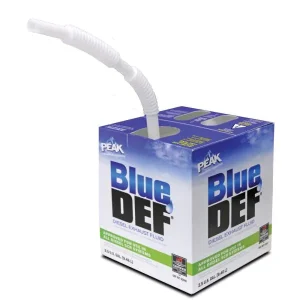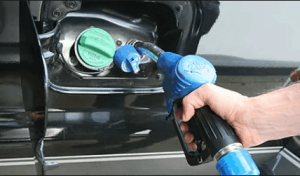When is Going DEF a Good Thing?
If you aren’t yet familiar with DEF, or diesel exhaust fluid, you soon will be. It’s the latest high-tech enhancement for diesel fuel, already being used by many trucking fleets and now coming into play with off-road construction equipment as well. This may seem like just another regulation to pay for and manage, but DEF can actually help boost your bottom line.
What is DEF?
 Diesel exhaust fluid is a liquid that combines high purity urea and water. Using a system called selective catalytic reduction, or SCR, the DEF is sprayed into your vehicle’s exhaust system, where it runs through a catalyst that separates nitrous oxide (NOx) into primarily water and nitrogen. The result is essentially harmless, whereas NOx is a major contributor to smog.
Diesel exhaust fluid is a liquid that combines high purity urea and water. Using a system called selective catalytic reduction, or SCR, the DEF is sprayed into your vehicle’s exhaust system, where it runs through a catalyst that separates nitrous oxide (NOx) into primarily water and nitrogen. The result is essentially harmless, whereas NOx is a major contributor to smog.
SCR technology helps diesel engines run cooler and use less fuel. That reduces wear and tear, and the money you save on diesel can more than pay for the cost of DEF.
Diesel exhaust fluid came on the scene for heavy highway trucks about three years ago, and industry-watchers expect DEF will soon be required for all heavy equipment engines over 74 hp.
Your engine will derate or shut down if the DEF reservoir runs day.
You can buy DEF in 55-gallon drums and 330-gallon totes to store at your shop. It’s also available in pump dispensers at truck stops that serve long distance haulers, and it comes in one-gallon cans, which many drivers keep handy as an emergency back-up supply.
Industry experts recommend you over-estimate your potential need for DEF until you have enough experience with it to identify your own usage pattern. It can take two or three days for a new order to arrive, so you should aim to always have enough on hand to last two or three weeks.
Obviously the amount of DEF you use will depend on your engine size and configuration as well as how you’re using the equipment. Typical DEF-to-diesel ratio is 2-3% for Class 8 on-road vehicles and can be 8-10% for off-roach equipment. Trucker experience thus far indicates that’s about one DEF reservoir fill-up for every three tanks of diesel.
But it’s harder to discern a pattern for construction machines because there’s so much variation among equipment and working conditions, especially factors such as idle time and load.
DEF is safe and easy to use.
 Because DEF isn’t toxic – it’s no more caustic than windshield wiper fluid — it’s not necessary to wear gloves or other protective gear when using it. Spills can be cleaned with soap and water or absorbed with sand or similar materials. You don’t need special storage, just a cool, dry, well ventilated area out of the sun. High temperatures won’t degrade the DEF, but it can freeze because water is a major ingredient.
Because DEF isn’t toxic – it’s no more caustic than windshield wiper fluid — it’s not necessary to wear gloves or other protective gear when using it. Spills can be cleaned with soap and water or absorbed with sand or similar materials. You don’t need special storage, just a cool, dry, well ventilated area out of the sun. High temperatures won’t degrade the DEF, but it can freeze because water is a major ingredient.
Diesel exhaust fluid can be dispensed with a hand pump or using an air- or electrically-powered pump. It works with pumps that are controlled by credit card readers, making it easy for fleet managers to track inventory and usage. But the pump you use must be compatible with DEF, and standard fuel pumps are not.
Aluminum or rubber components can contaminate the SCR system, permanently damaging the catalyst. For the same reason, petroleum-compatible hoses won’t work with DEF either, but proper equipment is available through several manufacturers. It’s also important to avoid contaminating the DEF itself, as foreign solids or liquids can also damage the catalyst. Replacement can run as high as $15,000.
Always purchase diesel exhaust fluid that carries an ISO 22241 certification. You can also look for certification from the American Petroleum Institute, but not all DEF has been tested to this standard because of the cost to manufacturers.
Going DEF is the future of diesel engines. But with a few precautions and personnel who understand what DEF is and how to use it, you can easily manage this latest technology.
